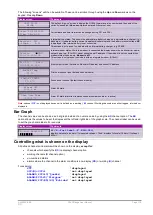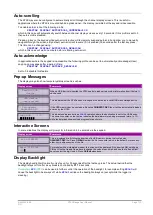
UM-0085-B09
DT80 Range User Manual
Page 106
RG
FTP Server
The
DT80
is also able to unload data to files on a remote server, using FTP (File Transfer Protocol).
An FTP transfer is initiated by specifying an
FTP Uniform Resource Identifier
(URI) as the value of the
dest=
option.
This URI has the form:
ftp://
username
:
password
@
host-ip
:
port
/
pathname
?priority=
priority
&interface=
interface
where:
•
username
is the user name to use when logging in to the FTP server
•
password
is the password to use when logging in to the FTP server
•
host-ip
is the IP address of the computer running the FTP server. This may be specified in numeric form (e.g.
192.168.1.23
), or as a domain name (e.g.
ftp.datataker.com
).
•
port
is the TCP port number to use – optional, default is port 21.
•
pathname
is the path (and, optionally, filename) into which to write the unloaded data.
•
priority
is optional and is either
normal
(default) or
low
. A normal priority unload will immediately trigger a
communications session if one is not already active, while a low priority unload will be queued until a session
next becomes active. This option is only applicable if the internal modem is being used. For Ethernet, the
priority is always
normal
.
•
interface
is applicable to DT8xM models only, and specifies the network interface to use:
modem
(default), or
ethernet
. For models without internal modem, Ethernet is always used and this option is ignored.
For an FTP transfer, the destination folder(s) are created in the same way as for a local unload. For example:
COPYD job=CAT9 dest=ftp://harryp:snitch@ftp.hsww.edu/transfig/
In this example, the
DT80
will log in to the FTP server
ftp.hsww.edu
using the username
harryp
and the password
snitch
, create the folder
/transfig/CAT9
, then unload all data for the CAT9 job to a file such as
002_20100314T090500.CSV
in that folder.
If an explicit filename is specified then data will be written to that file, e.g.
COPYD dest="ftp://harryp:snitch@ftp.hsww.edu/transfig/my data.csv"
See
Communications Sessions (P222)
for more details about how FTP transmission is managed.
Note:
When retrieving logged data by unloading it to an FTP server there must be sufficient space available on the
DT80
internal flash
drive to create a temporary file prior to sending to the server. The space required will depend on the amount of data being unloaded. If
you unload the entire contents of a 10MB storefile to FTP in DBD format then you will need 10MB free for the temporary file. If you
unload in CSV format then the space required will be of the order of 10MB, but may be less or more depending on the data values.
The unload data file will be queued for transfer using a communications session. The configured unload priority (
normal
or
low
)
determines whether or not a communications session will be immediately started in response to the unload.
Note:
No more than 12 FTP transfers can be queued; any subsequent attempts will be discarded (a message will be written to the event
log, and the
start=new
pointer will not be updated, so the next unload will contain additional data).
Also that:
•
The
DT80
always uses
passive mode
FTP transfers. Passive transfers are less likely to cause problems with
network firewalls.
•
If there are special characters, e.g.
@
in the username or filename parts of the URI then they must be
escaped
,
i.e. replaced by a special numeric sequence (
%
followed by the character's ASCII code, in hexadecimal).
@
characters should threfore be replaced with
%40
, e.g if your FTP username is
lucy@cows.org
then this would
be specified as:
dest=ftp://lucy%40cows.org:m00@ftp.cows.org/bovine23/
If there are spaces in the URI then then entire URI should be enclosed in quotes, as in the above example. Alternatively,
space characters can be escaped by replacing them with
%20
.
See
for more details.
















































